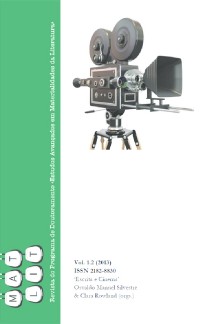Please use this identifier to cite or link to this item:
https://hdl.handle.net/10316.2/30061| Title: | Os Filmes (D)escritos de Ana Teresa Pereira: Nightmare, de Alfred Hitchcock, e The Double, de David Cronenberg | Authors: | Reis, Amândio Pereira | Keywords: | Ekphrasis;Literature and Cinema;Intermedia;Postmodernism;Written Film;Écfrase;Literatura e Cinema;Intermédia;Pós-modernismo;Written Film | Issue Date: | 2013 | Publisher: | Centro de Literatura Portuguesa | Abstract: | A partir de uma comparação inicial com um texto ecfrástico de Calístrato (séc. III), e apoiando-nos em seguida em vários estudos sobre a écfrase como prática literária, desde a Antiguidade até ao presente, e até à sua aceitação enquanto género literário intermedial, é nosso objetivo refletir sobre dois contos particulares de Ana Teresa Pereira que encenam a apresentação de filmes inexistentes de Hitchcock e Cronenberg. Para tal, passaremos tanto por um leque de problemas associados à descrição ecfrástica – tais como a dialética entre realidade e ficção, verdade e falsidade, e imaginação e leitura – e às (im)possibilidades da representação por palavras e/ou imagens, como por um conjunto de questões levantadas pela específica relação transmedial que os textos de A. T. Pereira estabelecem entre a Literatura e o Cinema. Atentaremos ainda ao conceito de “filme escrito” de Pavle Levi como uma hipótese, entre outras, de identificação genológica destas narrativas. Starting with a comparative reading of an ekphrastic text by Callistratus (3rd century AD) and taking support from various studies on ekphrasis as a literary practice, from antiquity to present times until its acceptance as an intermedial literary genre, it is our goal to analyze two short stories by Ana Teresa Pereira which invent non-existent films by Hitchcock and Cronenberg. Therefore, we will have to confront a range of problems associated with ekphrastic description – the dialectic between reality and fiction; truth and falsity; imagination and reading – and with the (im)possibilities of representation through image and/or words, including a set of questions posed by the specific transmedial relation that A. T. Pereira’s texts establish between Literature and Cinema. We will also take into account the concept of Pavle Levi’s “written film” as one possibility, among others, of a genre identification for these narratives. |
URI: | https://hdl.handle.net/10316.2/30061 | ISSN: | 2182-8830 | DOI: | 10.14195/2182-8830_1-2_2 |
| Appears in Collections: | Matlit |
Files in This Item:
| File | Description | Size | Format | |
|---|---|---|---|---|
| mt2_artigo2.pdf | 430.53 kB | Adobe PDF |  |
Items in DSpace are protected by copyright, with all rights reserved, unless otherwise indicated.
